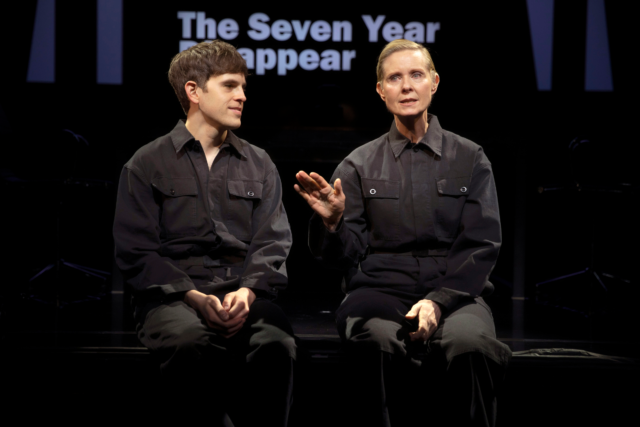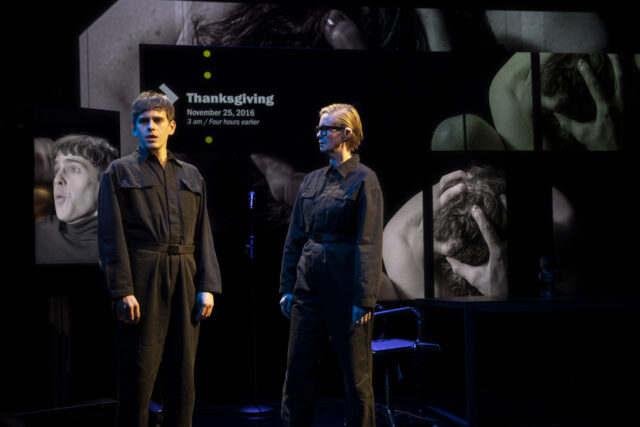
Taylor Trensch and Cynthia Nixon star in The Seven Year Disappear at the Signature (photo by Monique Carboni)
THE SEVEN YEAR DISAPPEAR
The New Group at the Pershing Square Signature Center
The Alice Griffin Jewel Box Theatre
480 West 42nd St. between between Ninth & Tenth Aves.
Tuesday – Saturday through March 31, $37-$72
thenewgroup.org
I’m a performance art junkie. Throw in some inventive video and I’m even more hooked. But not even those two elements could save me from the train wreck that is The Seven Year Disappear.
As the audience enters the Alice Griffin Jewel Box Theatre at the Pershing Square Signature Center for the New Group world premiere of Jordan Seavey’s play, Cynthia Nixon and Taylor Trensch are silently but intently staring at each other from opposite sides of a long table, wearing dark, militaryesque jumpsuits, surrounded by more than half a dozen monitors. A timeline crawl goes from 2009 to 2016 with such words as “Thanksgiving,” “Return,” “Art Basel,” and “MoMA.” It quickly becomes clear that they are re-creating Marina Abramović’s durational performance The Artist Is Present, which debuted at the Museum of Modern Art in 2010 and was documented in a 2012 film.
I visited Abramović’s MoMA show, which re-created many of her most famous pieces along with various video projects, several times. I saw her unique theatrical production, The Life and Death of Marina Abramović, at Park Avenue Armory in 2013. I experienced her gallery show “Generator,” in which visitors had to put on blindfolds and noise-canceling headphones.
But my Abramović obsession pales in comparison to Miriam’s in The Seven Year Disappear.
Miriam (Cynthia Nixon) is a performance artist whose work exists in the shadow of Abramović’s worldwide popularity. It’s 2009, and she’s furious that her rival has just received a major commission from the Whitney. “She’s such a fucking hypocrite,” Miriam tells her twenty-three-year-old son, Naphtali (Taylor Trensch). “I love Marina, she’s a friend . . . But God, this makes me so fucking mad.”
She rails against Abramović’s 2005 presentation of “Seven Easy Pieces” at the Guggenheim, arguing, “Re-creating seven famous performance pieces over seven nights, seven hours each night — how original!” Naphtali says, “Well — two of them were her own,” to which Miriam replies, “And five of them were not. ‘Seven Easy Pieces’ . . . yeah, art is easy when you just copy it.”
When Naphtali tells his mother that MoMA is going to commission a new work from her, Miriam is overjoyed. “I never liked the Whitney anyway,” she says. “Let them have Marina.”

New Group world premiere is its own performance art piece (photo by Monique Carboni)
Abramović doesn’t have any children, so Miriam has incorporated Naphtali into much of her work, perhaps as a kind of dig. (An epigraph in the script quotes Abramović: “I had three abortions because I was certain that [having a child] would be a disaster for my work. One only has limited energy in the body, and I would have had to divide it.”) For the MoMA piece, Naphtali will again be part of it, whether he wants to or not; Miriam has decided to disappear for seven years and seven months, without telling a soul where she will be or what she’ll be doing. Attempting to top Abramović, in this case the artist will not be present.
For ninety-five minutes, the narrative goes back and forth between 2009 and 2016, as Naphtali, who is a gay addict, meets with seven characters, all played by Nixon in different accents (and/or adding a small prop like glasses), from Miriam’s agent, Wolfgang, and MoMA curator Brayden to teenage manicurist Kaitlyn, private detective Nicole, and Tomás, who works with Naphtali on Hillary Clinton’s 2016 presidential campaign. Claiming that Naphtali is obsessed with Clinton, Tomás warns him, “She’s not your mom, ya know.”
Performance art is, by its very nature, conceptual and nonnarrative; theater, even the most experimental type, requires some form of storytelling, no matter how abstract or opaque.
In The Seven Year Disappear, Seavey (Homos, or Everyone in America; The Funny Pain) and director Scott Elliott (The Seagull/Woodstock, NY; Mercury Fur) try to have it both ways, and it fails miserably.
I remember eagerly walking through “The Artist Is Present,” a well-curated, well-designed exhibit that provided viewers a chance to breathe while experiencing the numerous, often participatory works. The Seven Year Disappear is an overstuffed muddle, throwing everything it can at the audience, which often doesn’t know where to look as live projections fight for attention with the two actors, who seem trapped by Qween Jean’s costumes and who occasionally bring out microphones for mostly unknown reasons. The set is by the usually innovative Derek McLane, with lighting by Jeff Croiter, sound by Rob Milburn and Michael Bodeen, and projections by John Narun that contribute to the confusion.
Early on, Trensch (Camelot, Hello, Dolly!) and Nixon (Rabbit Hole, The Little Foxes) rest at the front of the stage, their legs dangling over the lip, intimately connecting with the audience. But it’s not long before it all turns icy as Naphtali grows cold and distant, overwhelmed by a barrage of Lifetime-esque personal problems, and Nixon gets lost in a flurry of annoying characters doing annoying things in a hard-to-follow back-and-forth timeline.
I never got the opportunity to sit and stare with Abramović at MoMA, but, while watching The Seven Year Disappear, all too often I found myself staring in disbelief at her fictional archrival, which is not at all the same thing.
[Mark Rifkin is a Brooklyn-born, Manhattan-based writer and editor; you can follow him on Substack here.]